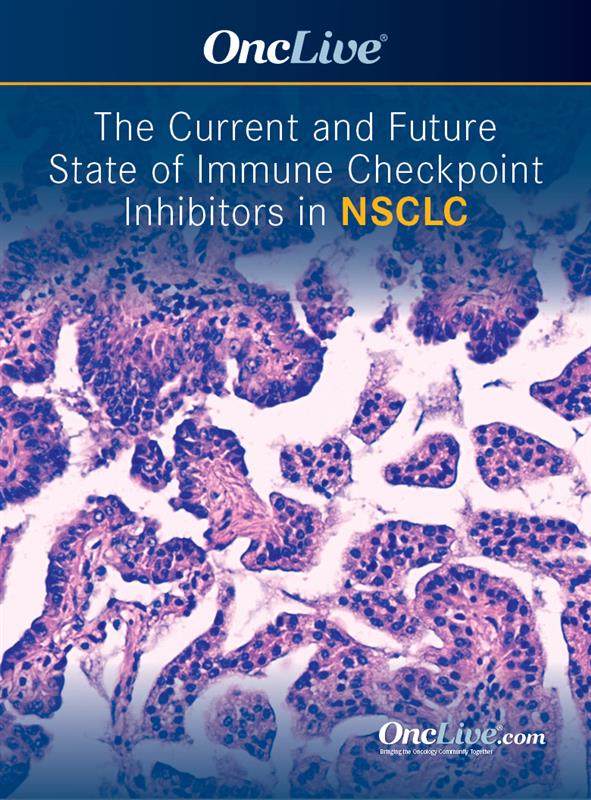Publication
Article
Frontline Nivolumab/Ipilimumab Plus Chemotherapy Sustains Survival Benefit in Metastatic NSCLC
Author(s):
Patients with metastatic non–small cell lung cancer treated with first-line nivolumab and ipilimumab plus chemotherapy experienced prolonged benefit in overall survival compared with those who received chemotherapy alone.
Luis G. Paz-Ares, MD

Patients with metastatic non–small cell lung cancer (NSCLC) treated with first-line nivolumab (Opdivo) and ipilimumab (Yervoy) plus chemotherapy experienced prolonged benefit in overall survival (OS) compared with those who received chemotherapy alone according to updated findings from the phase 3 CheckMate 9LA study (NCT03215706) presented at the 2022 ASCO Annual Meeting.1
At 36.1-month minimum follow-up, the median OS for patients receiving the combination therapy compared with those who received chemotherapy only was 15.8 months vs 11.0 months, respectively (HR, 0.74; 95% CI, 0.62-0.87). The 3-year OS rate with nivolumab/ipilimumab plus chemotherapy (n = 361) was 27% compared with 19% with chemotherapy alone (n = 358).
There was also OS benefit regardless of PD-L1 status. This trial also looked at outcomes based on PD-L1 expression of less than 1% (HR, 0.67; 95% CI, 0.51-0.88), 1% or more (HR, 0.74; 95% CI, 0.60-0.93), 1% to 49% (HR, 0.70; 95% CI, 0.53-0.93), and 50% or more (HR, 0.75; 95% CI, 0.53-1.07).
“We have previously shown that nivolumab plus ipilimumab plus 2 courses of chemotherapy significantly improve OS with no new safety signals as compared [with] chemotherapy alone in patients with metastatic NSCLC,” Luis G. Paz-Ares, MD, PhD,chair of the Medical Oncology Department at the Hospital Universitario 12 de Octubre, associate professor at the Universidad Complutense, and head of the Lung Cancer Unit at the CNIO (National Oncology Research Center), in Madrid, Spain, said in his presentation. “We continue to see a sustained improved survival for those patients.”
The CheckMate 9LA trial randomized adult patients with previously untreated stage IV or recurrent NSCLC 1:1 to nivolumab at 360 mg every 3 weeks, ipilimumab at 1 mg/kg every 6 weeks, and 2 cycles of chemotherapy every 3 weeks vs chemotherapy every 3 weeks for 4 cycles. Patients with nonsquamous disease on the chemotherapy-alone arm could also receive optional pemetrexed (Alimta) maintenance. The primary end point was OS. Secondary end points included PFS, objective response rate (ORR), and efficacy by PD-L1 expression, and the exploratory end point was efficacy by oncogenic driver mutation status.
The median age on the trial was 65 years in both arms and 30% of patients were female. Many of the patients had an ECOG performance status of 1 (68%), and the rest had a performance status of 0 (32%). Most patients were current or former smokers. Bone metastases were present in 27% of patients who received the combination and 31% who received chemotherapy alone, liver metastases were present in 19% and 20%, and central nervous system metastases were present in 18% and 16%. PD-L1 expression of less than 1% was identified in about 40% of patients, 1% or more in about 60%, 1% to 49% in 38% and 32%, and 50% or more in 22% and 29%.
Progression-free survival (PFS) and duration of response (DOR) benefits were sustained at 3 years with the combination. Additionally, outcomes were not affected by mutational status of KRAS, TP53, or STK11 in an exploratory analysis portion of the trial.
The median PFS for all randomized patients was 6.4 months in the nivolumab/ipilimumab arm and 5.3 months in the chemotherapy-alone arm at minimum follow-up of 35.2 months (HR, 0.70; 95% CI, 0.59-0.83). The ORR was 38% (95% CI, 33%-43%) compared with 25% (95% 21%-30%), respectively. There was a 12.4-month (95% CI, 8.7-20.1) median DOR and a 3-year DOR rate of 23% with immunotherapy versus 5.6 months (95% CI, 4.4-7.2) and 14% with chemotherapy, respectively.
For patients with PD-L1–negative disease, median PFS was 5.8 months for patients given nivolumab/ipilimumab plus chemotherapy (n = 135) compared with those given chemotherapy alone (n = 129) at 5.0 months (HR, 0.69; 95% CI, 0.52-0.91). Patients had a 32% (95% CI, 24%-40%) and 20% (95% CI, 14%-28%) ORR on the respective study arms. The median DOR was 17.5 months (95% CI, 6.9-38.9) vs 4.3 months (95% CI, 2.8-7.1), and there was a 3-year DOR rate of 37% vs 0%.
Lastly, for patients with PD-L1 expression of 1% or more, median PFS was 6.9 months on the experimental arm (n = 204) and 4.7 months on the chemotherapy arm (n = 204; HR, 0.71; 95% CI, 0.57-0.88). A 42% (95% CI, 35%-49%) ORR was observed for immunotherapy vs 28% (95% CI, 22%-34%) for chemotherapy alone. The median DOR was 11.3 months (95% CI, 8.5-20.3) compared with 5.6 months (95% CI, 4.4-9.6), respectively; the DOR rate at 3 years was similar, at 18% and 17%.
“Importantly, we didn't see a robust difference in benefit from the [CheckMate] 9LA regimen in patients depending on the mutational status,” Paz-Ares said. “The benefit [was] very consistent in patients with mutation in KRAS, TP53, orSTK11, and in patients with wild-type for those oncogenic drivers.”
Over two-thirds of patients (n = 492; 68%) on the trial had nonsquamous NSCLC, and among those patients, 313 (64%) had tissue evaluable for mutations. Thirty-nine percent of the evaluable patients had a KRAS mutation, 60% had a TP53 mutation, 27% had a STK11 mutation, and 10% had a KEAP1 mutation. These baseline characteristics were consistent with other nonsquamous and all-randomized populations with evaluable tissue. The subgroup of patients with KEAP1 mutations was small, therefore limiting data interpretation.
For patients on CheckMate 9LA, the safety profile was consistent with previous reports and no new safety signals were identified. Forty-eight percent of patients had grade 3 or 4 treatment-related adverse events (TRAEs) for those receiving immunotherapy and 38% among those receiving chemotherapy alone. Discontinuation due to any grade TRAEs occurred in 22% of those receiving immunotherapy and 9% of those receiving chemotherapy alone. For those receiving the immunotherapy combination, the median treatment duration was 6.1 months (range, 0-24.4) compared with 2.5 months (range, 0-46.1). Patients received a median of 9.0 doses of nivolumab (range, 1-36) and 4.0 doses of ipilimumab (range, 1-18). Of the patients on this arm, 93% received 2 cycles of chemotherapy.
Subsequent systemic therapy was given to 37% of all randomized patients on nivolumab/ipilimumab plus chemotherapy and 49% on chemotherapy only. Subsequent immunotherapy was received in 8% and 36% of patients, respectively, and subsequent platinum-doublet chemotherapy in 19% and 6%.
“This updated analysis further supports the use of nivolumab plus ipilimumab plus 2 courses of chemo[therapy] as first-line treatment options for patients with metastatic NSCLC regardless histology or PD-L1 expression,” Paz-Ares concluded.
Reference
- Paz-Ares LG, Ciuleanu T-E, Cobo-Dols M, et al. First-line (1L) nivolumab (NIVO) + ipilimumab (IPI) + 2 cycles of chemotherapy (chemo) versus chemo alone (4 cycles) in patients (pts) with metastatic non–small cell lung cancer (NSCLC): 3-year update from CheckMate 9LA. J Clin Oncol. 2022;40(suppl 17):LBA9026. doi:10.1200/JCO.2022.40.17_suppl.LBA9026










